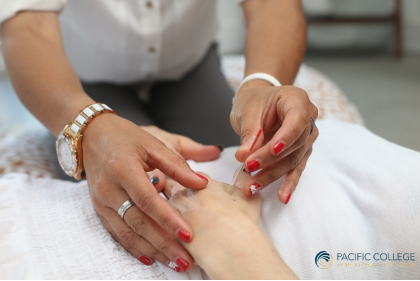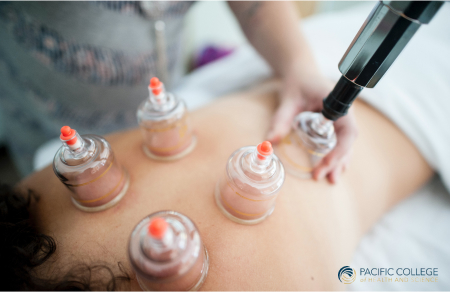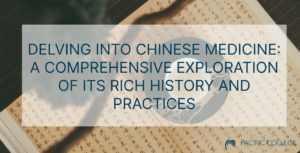Chinese medicine, with a history spanning millennia, has steadily gained recognition worldwide for its holistic and integrative approach to health and well-being. This age-old discipline emphasizes the interconnectedness of the body, mind, and spirit, offering a unique perspective on health care. In this comprehensive exploration, we will examine the history, key principles, and therapeutic practices of Chinese medicine, as well as the potential benefits and opportunities to study this ancient medical tradition.
“There were lots of alternatives on that street in those days, but no practitioners of Chinese medicine,”
KAPTCHUK, TED J., OMD, BA
A Journey Through Time: The History of Chinese Medicine
The origins of Chinese medicine can be traced back more than 3,000 years to the Huangdi Neijing or The Yellow Emperor’s Classic of Medicine. This seminal text outlines the foundational theories of Chinese medicine, paving the way for countless generations of practitioners to come.
Unraveling the Core Principles of Chinese Medicine
The Dance of Yin and Yang
Central to Chinese medicine is the concept of yin and yang. These two opposing yet complementary forces symbolize the natural qualities found throughout the universe, such as darkness and light, cold and heat, and passivity and activity. In relation to health, yin, and yang are indispensable for maintaining harmony within the body.
The Flow of Qi (Chi)
Qi is the vital life force that courses through the body, connecting and nourishing its various systems. Chinese medicine maintains that imbalances or obstructions in the flow of qi can lead to illness or discomfort. By re-establishing the balance of qi, practitioners aim to enhance overall health and well-being.
The Five Elements Theory: A Framework for Understanding Health
The Five Elements—Wood, Fire, Earth, Metal, and Water—are another cornerstone of Chinese medicine. These elements correspond to different organs, tissues, and emotions, influencing the body’s functions and well-being. Balancing these elements is crucial for maintaining harmony within the body.
The Rich Tapestry of Chinese Medicine Practices
Chinese medicine encompasses an array of therapeutic techniques, each with its unique approach to fostering health and well-being. Let’s delve deeper into these diverse practices and discover the benefits they offer.
Acupuncture: A Time-Honored Technique for Balancing Qi
Acupuncture is an ancient practice that involves the insertion of fine needles into specific points on the body, known as acupuncture points or meridians. These points are believed to be connected to various organs and systems, and by stimulating them, practitioners can influence the flow of qi and promote healing.

Numerous studies have demonstrated acupuncture’s effectiveness in treating a wide range of conditions, including:
- Chronic pain management
- Stress and anxiety relief
- Sleep disorders
- Migraines and tension headaches
- Allergies and sinus issues
- Menstrual and fertility concerns
Cupping Therapy: Ancient Healing Through Suction

Cupping therapy is another traditional Chinese medicine technique that has gained popularity in recent years. This practice involves the application of cups, typically made of glass, silicone, or bamboo, onto the skin to create suction. The suction stimulates blood circulation, encourages the flow of qi, and helps to release muscle tension and alleviate pain.
There are two primary methods of cupping:
- Dry Cupping: In this method, a vacuum is created inside the cup, either through heat or a suction device, before placing it on the skin. The cup is then left in place for several minutes, allowing the skin to rise and redden as blood vessels expand.
- Wet Cupping: Wet cupping, also known as “hijama” or “bloodletting,” involves making small, superficial incisions on the skin after the dry cupping process. This allows for the release of stagnant blood and toxins, further promoting the body’s natural healing process.
Cupping therapy can provide a range of benefits, including:
- Relief from muscle pain and tension
- Improved circulation and blood flow
- Reduced inflammation and swelling
- Enhanced relaxation and stress relief
- Detoxification and improved immune function
It is essential to note that cupping therapy should always be performed by a qualified practitioner to ensure safety and effectiveness. Temporary discoloration or bruising of the skin is a common side effect of cupping, but these marks generally fade within a few days.
By incorporating cupping therapy into your health care routine, you can experience another facet of Chinese medicine’s diverse and holistic approach to fostering well-being and vitality.
Herbal Medicine: Harnessing the Power of Nature

Herbal medicine is a vital component of Chinese medicine, utilizing natural herbs and plants to address various health conditions. Practitioners prescribe customized herbal formulas based on each individual’s unique needs, taking into account their body constitution, symptoms, and overall health.
Chinese herbal medicine can be administered in various forms, such as teas, capsules, tinctures, or topical applications. Some common applications of herbal medicine include:
- Strengthening the immune system
- Reducing inflammation
- Improving digestion
- Alleviating respiratory issues
- Promoting mental clarity and focus
- Supporting hormonal balance
Tui Na Massage: The Art of Healing Touch

Tui Na massage, often referred to as “Chinese medical massage,” is a form of therapeutic massage that focuses on restoring qi balance and alleviating tension. Practitioners employ a variety of techniques, such as kneading, pressing, and rolling, to manipulate the soft tissues and stimulate the flow of qi.
Tui Na massage can provide relief for a range of conditions, including:
- Musculoskeletal pain and stiffness
- Sports injuries and muscle strains
- Neck, shoulder, and back pain
- Stress and anxiety
- Digestive disorders
- Insomnia and sleep disturbances
Are you interested in becoming a certified massage therapist?
Visit the links below to explore our massage therapy programs at a campus near you:
Tai Chi and Qigong: Cultivating Mind-Body Harmony
Tai Chi and Qi gong are ancient Chinese practices that combine slow, graceful movements with deep breathing exercises and meditation to enhance QI flow and overall health. While Tai Chi is often considered a martial art, its focus on balance, flexibility, and mental clarity makes it a valuable tool for health and well-being.
Practicing Tai Chi and Qigong can provide numerous benefits, such as:
- Improved strength, flexibility, and balance
- Enhanced mental focus and concentration
- Reduced stress and anxiety
- Better cardiovascular health
- Increased energy levels
- Greater self-awareness and mindfulness
Incorporating these diverse practices into your healthcare routine can help you experience the full spectrum of benefits that Chinese medicine has to offer. By exploring these techniques, you can cultivate a deeper understanding of your body and its needs, ultimately leading to a more harmonious, balanced state of being.
The Promise of Chinese Medicine: Potential Benefits for Health and Wellness
While the efficacy of Chinese medicine continues to be a subject of debate, numerous studies have indicated its potential benefits. For instance, acupuncture has been shown to be effective in treating chronic pain, anxiety, and sleep disorders. Additionally, herbal medicine and other practices may provide relief for conditions such as:
- Digestive issues
- Respiratory ailments
- Cardiovascular health
- Mental health concerns
- Immune system support
Learn from the Best: Studying Chinese Medicine at the Pacific College of Health and Science
For those interested in delving deeper into the world of Chinese medicine, the Pacific College of Health and Science offers exceptional programs in acupuncture and massage therapy, among others. Aspiring practitioners can study under experienced professionals, honing their skills in this ancient medical tradition.
6. Ensuring Optimal Care: Finding a Qualified Chinese Medicine Practitioner
To ensure the best possible care, it’s essential to seek out a qualified Chinese medicine practitioner. The National Certification Commission for Acupuncture and Oriental Medicine (NCCAOM) is a reputable resource for finding certified professionals in your area.
In conclusion, Chinese medicine offers a unique and holistic perspective on health and wellness. By understanding its core principles and practices, you can harness its potential benefits and achieve a more balanced, harmonious state of being. As interest in this ancient discipline continues to grow, the opportunities to study and practice Chinese medicine, such as those offered at the Pacific College of Health and Science, will equip the next generation of practitioners with the knowledge and skills necessary to promote health and well-being in their communities.
Chinese traditional medicine – FAQ
What is the basis of Chinese traditional medicine?
The basis of Chinese traditional medicine is the belief in the interconnectedness of the body, mind, and spirit, and the importance of maintaining balance and harmony among these elements. Core principles include yin and yang, qi (vital energy), and the Five Elements Theory.
What is moxibustion in Chinese medicine?
Moxibustion is a traditional Chinese medicine technique that involves burning dried mugwort (moxa) near or on specific acupuncture points to stimulate qi flow, warm the body, and promote healing.
What is qi in Chinese medicine?
Qi (pronounced “chi”) is the vital energy or life force that flows through the body along pathways called meridians. In Chinese medicine, maintaining a balanced flow of qi is essential for overall health and well-being.
What is traditional Chinese medicine?
Traditional Chinese medicine (TCM) is an ancient medical system that seeks to diagnose, treat, and prevent illnesses through a holistic approach, focusing on the balance of the body, mind, and spirit. TCM practices include acupuncture, herbal medicine, Tui Na massage, Tai Chi, Qigong, and dietary therapy.
What does a white tongue mean in Chinese medicine?
In Chinese medicine, a white tongue coating may indicate the presence of cold or dampness in the body, often associated with digestive issues, fatigue, or a weakened immune system.
How old is Chinese medicine?
Chinese medicine is over 3,000 years old, with the earliest records found in the Huangdi Neijing, or The Yellow Emperor’s Classic of Medicine.
What is Chinese herbal medicine?
Chinese herbal medicine is a key component of traditional Chinese medicine, utilizing natural herbs and plants to create customized formulas for treating various health conditions. It aims to address the root cause of illnesses and restore balance in the body.
How to Become a Practitioner of Chinese Medicine
Becoming a practitioner of Chinese medicine is a rewarding and fulfilling journey that requires dedication, passion, and a strong foundation in both theory and practice. Here is a step-by-step guide to help you embark on this path and become a skilled practitioner in the field of Chinese medicine:
1. Explore the Various Disciplines of Chinese Medicine
The first step is to gain a comprehensive understanding of the different aspects of Chinese medicine, such as acupuncture, herbal medicine, Tui Na massage, Tai Chi, and Qigong. Familiarize yourself with their core principles and therapeutic techniques to determine which areas resonate with you the most and align with your personal interests and goals.
2. Pursue Formal Education and Training
To become a qualified practitioner, you will need to enroll in a recognized educational program that offers comprehensive training in Chinese medicine. Institutions like the Pacific College of Health and Science provide accredited programs in acupuncture, herbal medicine, and massage therapy, among others. These programs typically involve both classroom instruction and hands-on clinical experience.
Courses in such programs may cover subjects like:
- Traditional Chinese medical theory
- Acupuncture point location and techniques
- Chinese herbal medicine and formulations
- Tui Na massage techniques
- Tai Chi and Qigong practice
- Western medical sciences (anatomy, physiology, and pathology)
- Nutrition and dietary therapy
- Ethics and professional development
3. Obtain Licensure and Certification
In most countries and states, practitioners of Chinese medicine are required to be licensed or certified. In the United States, for instance, you will need to pass the examination administered by the National Certification Commission for Acupuncture and Oriental Medicine (NCCAOM) to become a certified practitioner.
Licensing requirements may vary by state, so it’s essential to research the specific regulations and standards applicable to your area. Some states may also require additional education, training, or examinations in order to obtain licensure.
4. Gain Practical Experience
Once you have completed your education and obtained the necessary certifications, it is crucial to gain practical experience in the field. Consider working under the supervision of an experienced practitioner, completing internships, or participating in clinical residencies to refine your skills and develop your professional network.
5. Establish Your Practice
After gaining hands-on experience, you can start your own practice or join an established clinic or wellness center. As you build your reputation and clientele, it’s essential to stay up-to-date with the latest developments and best practices in Chinese medicine through continuing education and professional development opportunities.
By following these steps and dedicating yourself to the study and practice of Chinese medicine, you can become a skilled practitioner capable of making a meaningful impact on the health and well-being of your patients.
Featured Posts:

